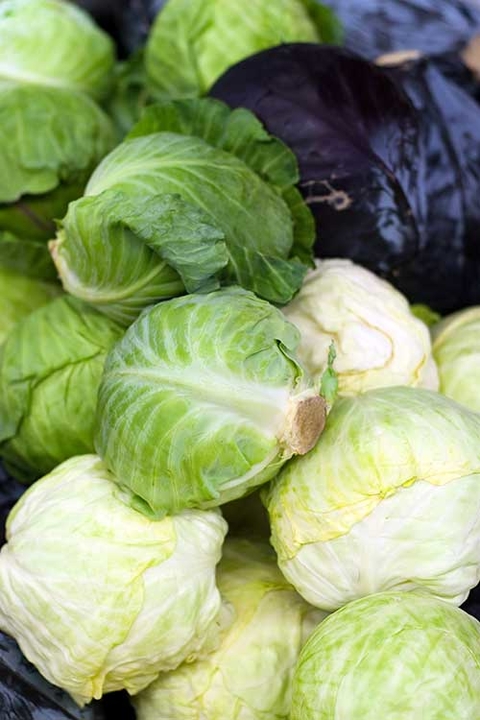The word sauerkraut means "sour cabbage" in German; it's naturally fermented cabbage. Natural fermentation is one of the oldest means of food preservation and it reduces the risk of foodborne illness and food spoilage.
Nutritional value of sauerkraut
Sauerkraut is a low-calorie food; only 42 calories per cup. It's a good source of vitamin C. It's high in sodium because of the salt used in fermentation. Reduce the sodium content, as well as the tartness, by rinsing sauerkraut in cold water before using.
Use high-quality cabbage and canning salt
Sauerkraut can easily be made and preserved at home with its basic ingredients of cabbage and salt. Use a researched tested recipe, as the proportion of salt to cabbage is critical to the quality and safety of sauerkraut.
To make good sauerkraut begin by selecting disease-free, firm, sweet, mature heads of cabbage from mid- and late-season crops. Begin cleaning and shredding the cabbage within 24 to 48 hours of harvest. Using a kraut cutter is a traditional way to shred the cabbage, but a modern food processor moves the process along and saves on the fingers.
Canning or pickling salt draws out the cabbage juice so it can be fermented. Using too little salt not only softens the cabbage but also yields a product lacking in flavor. Too much salt delays the natural fermentation process. For every 5 pounds of shredded cabbage, mix in 3 tablespoons of canning salt.
Choose the right container to ferment the cabbage
The choice of container to pack the cabbage in is important. Old-fashioned earthenware crocks are traditional and are still a good choice as long as they are not cracked or chipped. Food-grade plastic pails that are sturdy and rigid make excellent containers. You do not want to make sauerkraut in metal containers of any type or in plastic containers that were never intended for food use.
Pack tightly and cover the cabbage
Once the cabbage and salt mixture is packed tightly into a suitable container, it's essential that you cover the cabbage and liquid to exclude air since the fermentation process requires an anaerobic (air-tight) condition. A salt-water (brine-filled), a food-grade plastic bag is one of the easiest and best ways to both cover and weigh down the cabbage.
Temperature range needed for fermentation
Store the container at 70 to 75 F while fermenting. At these temperatures, the sauerkraut will be ready in 3 to 4 weeks.
- At 70 to 75 F, kraut will be fully fermented in about 3 to 4 weeks.
- At 60 to 65 F, fermentation may take 5 to 6 weeks.
- At temperatures lower than 60 F, kraut may not ferment.
- Above 75 F, kraut may become soft.
Sauerkraut recipe
Yield: about 9 quarts
Ingredients
- 25 lbs. cabbage
- 3/4 cup canning or pickling salt
Procedure
Work with about 5 pounds of cabbage at a time.
Shred the cabbage
- Discard outer leaves.
- Rinse heads under cold running water and drain.
- Cut heads in quarters and remove cores.
- Shred or slice to a thickness of a quarter.
Put in containers and add salt
- Put cabbage in a suitable fermentation container and add 3 tablespoons of salt.
- Mix thoroughly, using clean hands.
- Pack firmly until salt draws juices from cabbage.
Repeat shredding, salting and packing until all cabbage is in the container
- Be sure the container is deep enough so that its rim is at least 4 or 5 inches above the cabbage.
- If juice does not cover the cabbage, add boiled and cooled brine (1-1/2 tablespoons of salt per quart of water).
Add plate and weights, and cover the container with a clean bath towel. Store at 70 to 75F while fermenting.
During fermentation:
- If you weigh the cabbage down with a brine-filled bag, don't disturb the crock until normal fermentation is completed (when bubbling ceases).
- If you use a plate and jars as weights, you will have to check the kraut 2 to 3 times each week and remove scum if it forms.
Fully fermented sauerkraut may be canned or frozen
To can sauerkraut:
- Hot pack: Bring kraut and liquid slowly to a boil in a large kettle, stirring frequently. Remove from heat and fill jars rather firmly with kraut and juices, leaving ½ inch headspace.
- Raw pack: Fill jars firmly with kraut and cover with juices, leaving ½ inch headspace.
- Wipe jar rim and adjust lids.
- Process in a boiling water bath.
- Raw pack: process pints for 25 minutes and quarts for 30 minutes.
- Hot pack: process pints for 15 minutes and quarts for 20 minutes.
To freeze sauerkraut:
- Fill pint- or quart-size freezer bags or reusable ridge plastic freezer containers.
- Fill to 1 - 2 inches from their tops, squeeze out air, seal and label.
- Freeze for 8 - 12 months.
- National Center for Home Food Preservation. Preparing and Canning Fermented Foods — Sauerkraut.
- USDA. 2015. Complete Guide to Home Canning Guide 6. Preparing and Canning Fermented Foods and Pickled Vegetables, pp. 6-8, 6-9.
Reviewed in 2021



